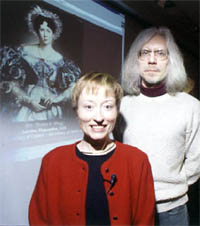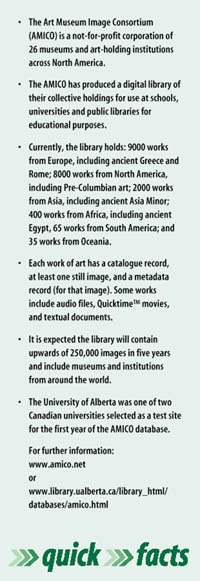
|
Bringing the world's treasures closer to home |
University of Alberta selected as test site for art database on the web
Folio Staff

Allyson Merrison Paynter and Marlessa Kuntz use the AMICO library for an art history course |
Pull up a chair and pour another cup of coffee. Itís time to let your fingers do the walking and take a cyber-stroll through New Yorkís Metropolitan Museum of Art. Or perhaps the National Gallery in Ottawa. Or how about sauntering through the fine arts museums in San Francisco, Montreal and Boston?
All possible now for U of A faculty, students and staff thanks to the Art Museum Image Consortium (AMICO) database. The AMICO library is a digital dream of 20,000 works from 26 museums and institutions across North America wanting to make their holdings more accessible to the public for educational purposes. To test the database in its inaugural year, the consortium selected 18 universities in Canada, the US and the Netherlands from more than 80 applications for a one-year license.
And the University of Alberta was one of two Canadian sites chosen as test-bed participants because of its proposal to use the digital library with technology to enhance lectures (University of Toronto was also selected). The U of A is in good companyóCarnegie Mellon, Columbia, Harvard and Princeton University were some of the other test sites selected.

Collen Skidmore and Michael May |
So, want to compare Monet to Manet? De Chirico to Da Vinci? Log onto the AMICO database on the U of Aís library Web site and get your mouse clicking.
Canadian art history students first used the AMICO library in Colleen Skidmoreís Thursday morning class. "The noise level was so high," laughs the assistant professor, recalling the excitement in the room as students pulled up images, compared works side-by-side, and checked out various sizes of the art available on their computer screens. Through software developed by Academic Technologies for Learning, Skidmore was able to add more bells and whistles to AMICO and adapt it for her lectures.
"Itís a big change," says Skidmore. With a password, students have access to Skidmoreís online component and can print color reproductions of art for study purposes. That means they no longer have to book time to load and view slides. Itís also accessible from home, day or night, so students have more control over their studying. As for quality, "Iím so impressed," says Skidmore. "The quality is much beyond what I expected, and the large presentation sizes donít break down too badly."

|
But donít think one can have free access to the art for commercial purposes. The members of AMICO maintain copyright on their holdings. The library is strictly for educational purposes. Any other uses and the institution can have its license revoked.
"Our agreements with them are a social contract," says David Bearman, AMICOís director of strategy and research. "If they learn about violations of the rule, that users may not use the works commercially, they will act against those users or lose their subscription rights. We prefer this social contract to technological means of control."
With the incredible access to art expected to expand to 250,000 works in five years, potentially from around the globe, you can be sure universities, and in future schools and libraries, will safeguard their license. At the University of Alberta, thatís Michael Mayís job. Any questions about its uses are directed to him, as indicated on the Humanities and Social Sciences Web site. Itís a license he does not wish to lose.
"AMICO is pretty much a bargain at $10,000 US for 20,000 images," says May, liaison librarian for art and design, and classics, who points out the group behind this is a not-for-profit corporation. "Weíve been quoted $75 per digital image from a major Canadian museum. With pricing like this, the AMICO library would cost $1.5 million."
Itís a completely different way of thinking for many museums, to have their treasured works out there in cyberspace and vulnerable to misuse. But itís a fear they have obviously overcome, says May. "On the other hand, they may have been pushed into doing it because Bill Gates has been doing various things in this area. He published on CD images from the Louvre and he has also purchased a new, large stock-photography business," says May. "Just the threat from him made museums quite nervous."
Does this mean that turnstiles across the continent could grind to a halt because of images easily accessible on the screen? Just the opposite, says Skidmore. "My sense is this will encourage people to see things in person. Itís great for people who canít travel. But thereís always that group of tourists that moves from gallery to gallery."
Says Bearman, "People still line up to see the Mona Lisa, after all."

Folio front page |

Office of Public Affairs |

University of Alberta |